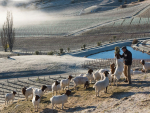Methane campaign is 100% politics
OPINION: We are endlessly told that livestock are responsible for half of New Zealand's total emissions.
OPINION: Over the years, the use of sulphur dioxide in winemaking has become a complex subject associated with several drawbacks, such as aroma defects and health-related problems.
The maximum concentration of SO2 allowed in wines has been progressively lowered by the International Organisation of Vine and Wine, while recommended limiting SO2 as much as possible, or even completely, from the treatment of foods.
In New Zealand and South Africa, using tea extracts from Camelia sinensis and Aspalathus linearis to replace SO2 has been conducted in commercial winemaking. New Zealand wine company Loveblock has a Sauvignon Blanc Tee wine made using a green tea tannin-based product (Ti Premium, Vason Enologica, Italy) as the only preservative. Green tea extract is known for its health benefits as well as improving the shelf life of food products due to its high antioxidant activity. Green tea leaves are rich in phenolics, where flavan-3-ols make up to 90% of the tea phenolic content. However, it was unclear how much antioxidant capacity the green tea flavan-3-ols could provide to protect wines from oxidation, and how much the subsequent polymerisation of flavan-3-ols induced by oxidation would affect wine sensory attributes.
A collaboration between the University of Auckland Wine Science Programme, the School of Viticulture and Wine Science at the Eastern Institute of Technology, and the Centre for Viticulture and Oenology at Lincoln University, investigated the antioxidant capacity of green tea extract at two rates (0.1 and 0.2 g/L), for their effects on Sauvignon Blamnc wine colour stability, phenolic composition, antioxidant capacity, and sensory attributes. Five monomeric phenolic compounds were detected in a pure green tea extract prepared especially for this experiment, and their concentrations ranged in the order (-) epigallocatechin gallate > (-)-epigallotechin > (-)-epicatechin > (-)-epicatechin gallate > gallic acid. At the studied addition rates, these green tea-derived phenolic compounds contributed to ~70% of the antioxidant ~71% of the total phenolics, and ~84% of the tannin concentration of the green tea extract.
The green tea treatments significantly increased the wine's colour absorbance at 420nm (the yellow colour), tannin concentration, and total phenolic content. As the lower addition rate, the green tea treatment showed a similar antioxidant capacity to an SO2 treatment at 50 mg/L. Meanwhile, increasing the addition rate of green tea extract to 0.2 g/L significantly increased the wine's antioxidant capacity by 44%. However, when exposed to excessive oxygen and high temperature (50C), the green tea treatments exhibited ~29% and 24% higher browning capacity than the control treatment. Thus, the storage conditions are highly critical to wines treated with green tea extracts.
After five months of bottle storage, the sensory study revealed that the green tea and SO2 treatments were quite similar. Therefore, despite producing wines with distinct chemical profiles, using green tea extract to replace SO2 did not negatively impact the perceptible colour and mouthfeel attributes of Sauvignon Blanc wine. Next, we will examine the perceptible aroma and flavour profiles of wines treated with green tea extract for SO2 replacement.
Dr Billy Yang is a Research Fellow at the School of Chemical Sciences at University of Auckland, Dr Victor Ye, Dr Leandro Dias Araujo, and Professor Paul Kilmartin coauthored the report in Food Chemistry - 'Replacing SO2 with Green Tea Extracts in Sauvignon Blanc Winemaking: Effects on Wine Phenolic Composition, Antioxidant Capacity, and Sensory Attributes'. To read the full study go to doi.org/10.1016/j.foodchem.2024.138976

The end of the year is fast approaching, so here are some thoughts on a few of the significant developments…

OPINION: When I moved to Marlborough two decades ago, I found countless lines of tidy vines, neatly mowed and carefully…
The large 2025 harvest will exacerbate the wine industry's "lingering" supply from recent vintages, New Zealand Winegrowers Chief Executive Philip…
If you find a new consumer in a developed wine market, you are taking them from someone else, says Blank…
OPINION: Sauvignon Blanc was famously introduced to New Zealand by Ross Spence of Matua Valley, and then serendipitously planted in…